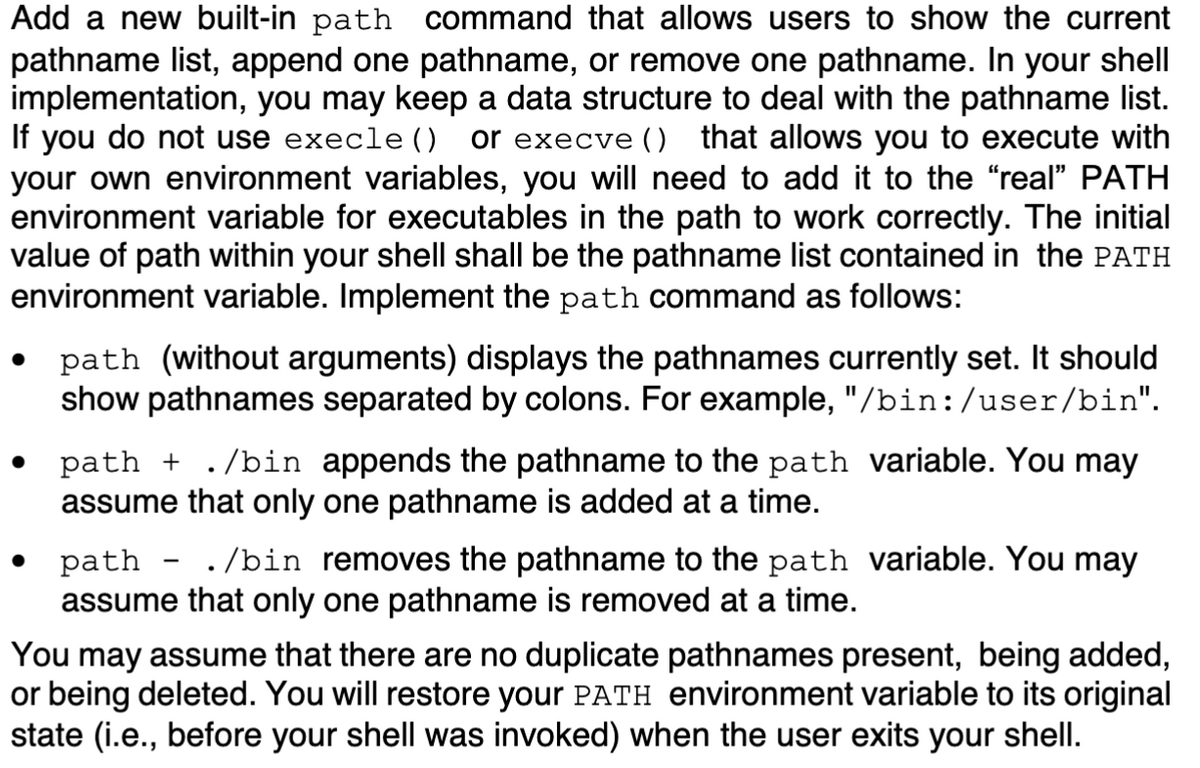Add a new built-in path command that allows users to show the current pathname list, append one pathname, or remove one pathname. In your shell implementation, you may keep a data structure to deal with the pathname list. If you do not use execle () your own environment variables, you will need to add it to the "real" PATH environment variable for executables in the path to work correctly. The initial value of path within your shell shall be the pathname list contained in the PATH environment variable. Implement the path command as follows: or execve () that allows you to execute with • path (without arguments) displays the pathnames currently set. It should show pathnames separated by colons. For example, "/bin:/user/bin". • path + ./bin appends the pathname to the path variable. You may assume that only one pathname is added at a time. path - ./bin removes the pathname to the path variable. You may assume that only one pathname is removed at a time. You may assume that there are no duplicate pathnames present, being added, or being deleted. You will restore your PATH environment variable to its original state (i.e., before your shell was invoked) when the user exits your shell.
Add a new built-in path command that allows users to show the current pathname list, append one pathname, or remove one pathname. In your shell implementation, you may keep a data structure to deal with the pathname list. If you do not use execle () your own environment variables, you will need to add it to the "real" PATH environment variable for executables in the path to work correctly. The initial value of path within your shell shall be the pathname list contained in the PATH environment variable. Implement the path command as follows: or execve () that allows you to execute with • path (without arguments) displays the pathnames currently set. It should show pathnames separated by colons. For example, "/bin:/user/bin". • path + ./bin appends the pathname to the path variable. You may assume that only one pathname is added at a time. path - ./bin removes the pathname to the path variable. You may assume that only one pathname is removed at a time. You may assume that there are no duplicate pathnames present, being added, or being deleted. You will restore your PATH environment variable to its original state (i.e., before your shell was invoked) when the user exits your shell.
Database System Concepts
7th Edition
ISBN:9780078022159
Author:Abraham Silberschatz Professor, Henry F. Korth, S. Sudarshan
Publisher:Abraham Silberschatz Professor, Henry F. Korth, S. Sudarshan
Chapter1: Introduction
Section: Chapter Questions
Problem 1PE
Related questions
Question
void Path()
{
char[] userInput =" ";
system("echo $PATH");
//append the path
system("export PATH=$PATH:");
scanf("%c", userInput);
printf("%c", "path + %c", userInput);
}
PLEASE FIX THIS FUNCTION!!! (C PROGRAMMING )

Transcribed Image Text:Add a new built-in path command that allows users to show the current
pathname list, append one pathname, or remove one pathname. In your shell
implementation, you may keep a data structure to deal with the pathname list.
If you do not use execle ()
your own environment variables, you will need to add it to the "real" PATH
environment variable for executables in the path to work correctly. The initial
value of path within your shell shall be the pathname list contained in the PATH
environment variable. Implement the path command as follows:
or execve () that allows you to execute with
path (without arguments) displays the pathnames currently set. It should
show pathnames separated by colons. For example, "/bin:/user/bin".
path + ./bin appends the pathname to the path variable. You may
assume that only one pathname is added at a time.
path - ./bin removes the pathname to the path variable. You may
assume that only one pathname is removed at a time.
You may assume that there are no duplicate pathnames present, being added,
or being deleted. You will restore your PATH environment variable to its original
state (i.e., before your shell was invoked) when the user exits your shell.
Expert Solution
This question has been solved!
Explore an expertly crafted, step-by-step solution for a thorough understanding of key concepts.
This is a popular solution!
Trending now
This is a popular solution!
Step by step
Solved in 4 steps with 3 images

Knowledge Booster
Learn more about
Need a deep-dive on the concept behind this application? Look no further. Learn more about this topic, computer-science and related others by exploring similar questions and additional content below.Recommended textbooks for you

Database System Concepts
Computer Science
ISBN:
9780078022159
Author:
Abraham Silberschatz Professor, Henry F. Korth, S. Sudarshan
Publisher:
McGraw-Hill Education

Starting Out with Python (4th Edition)
Computer Science
ISBN:
9780134444321
Author:
Tony Gaddis
Publisher:
PEARSON

Digital Fundamentals (11th Edition)
Computer Science
ISBN:
9780132737968
Author:
Thomas L. Floyd
Publisher:
PEARSON

Database System Concepts
Computer Science
ISBN:
9780078022159
Author:
Abraham Silberschatz Professor, Henry F. Korth, S. Sudarshan
Publisher:
McGraw-Hill Education

Starting Out with Python (4th Edition)
Computer Science
ISBN:
9780134444321
Author:
Tony Gaddis
Publisher:
PEARSON

Digital Fundamentals (11th Edition)
Computer Science
ISBN:
9780132737968
Author:
Thomas L. Floyd
Publisher:
PEARSON

C How to Program (8th Edition)
Computer Science
ISBN:
9780133976892
Author:
Paul J. Deitel, Harvey Deitel
Publisher:
PEARSON

Database Systems: Design, Implementation, & Manag…
Computer Science
ISBN:
9781337627900
Author:
Carlos Coronel, Steven Morris
Publisher:
Cengage Learning

Programmable Logic Controllers
Computer Science
ISBN:
9780073373843
Author:
Frank D. Petruzella
Publisher:
McGraw-Hill Education